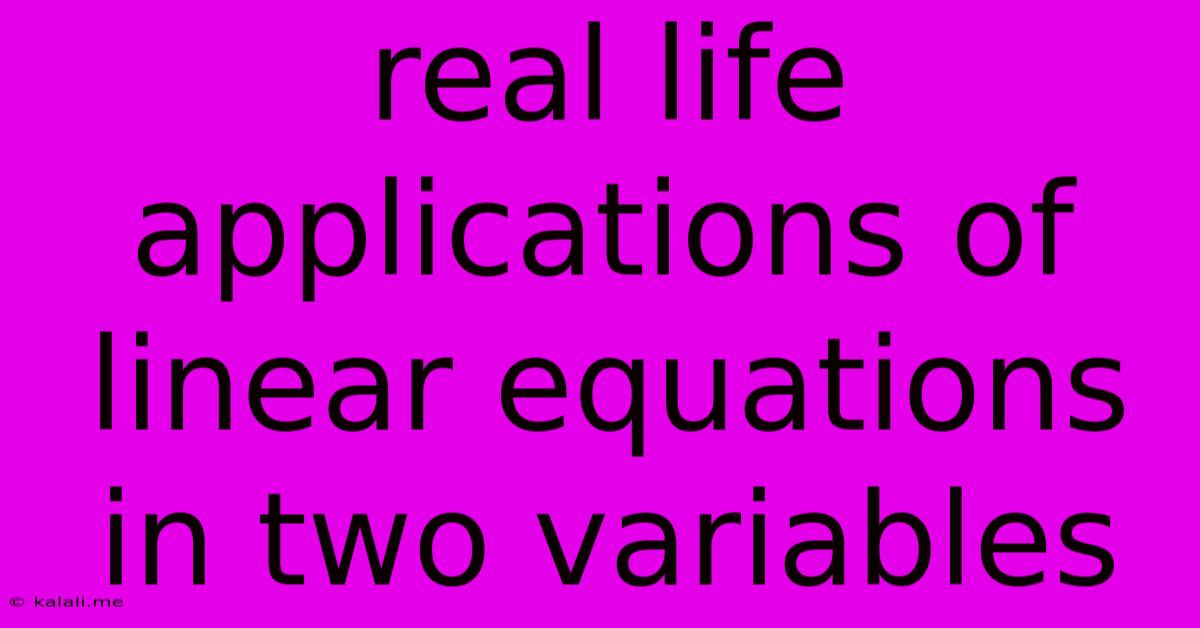Real Life Applications Of Linear Equations In Two Variables
Kalali
Jun 14, 2025 · 3 min read

Table of Contents
Real-Life Applications of Linear Equations in Two Variables
Linear equations in two variables, typically represented as ax + by = c, might seem like a purely mathematical concept, confined to textbooks and classrooms. However, the truth is that these equations are incredibly useful tools with a wide array of real-life applications across various fields. This article will explore some practical examples, demonstrating their versatility and importance in everyday situations. Understanding these applications can make the concept more engaging and relevant for students and professionals alike.
Understanding the Basics: What are Linear Equations in Two Variables?
Before diving into the applications, let's quickly recap the basics. A linear equation in two variables is an equation that can be written in the form ax + by = c, where 'a', 'b', and 'c' are constants, and 'x' and 'y' are variables. The graph of a linear equation is always a straight line. The key feature is the linear relationship between the variables – a constant change in one variable corresponds to a constant change in the other.
Real-World Applications: Where Linear Equations Shine
The power of linear equations lies in their ability to model relationships between two quantities that change proportionally. Here are some prominent examples:
1. Business and Finance:
- Cost Analysis: Businesses use linear equations to determine the total cost of production. For example, if the fixed cost is $500 and the cost per unit is $10, the total cost (y) can be expressed as:
y = 10x + 500, where x is the number of units produced. This allows businesses to predict costs at different production levels and make informed pricing decisions. - Profit Calculation: Building on cost analysis, businesses can calculate profit (y) using a similar equation, considering revenue (typically a linear function of sales) and costs.
Profit = Revenue - Cost. - Simple Interest: Calculating simple interest earned on an investment involves a linear equation. The interest earned (I) can be expressed as
I = Prt, where P is the principal amount, r is the interest rate, and t is the time.
2. Science and Engineering:
- Physics: Many physical phenomena, such as motion with constant velocity, can be modeled using linear equations. For example, the distance (d) traveled by an object moving at a constant speed (v) for time (t) is given by:
d = vt. - Chemistry: Linear equations are used in stoichiometry calculations to determine the quantities of reactants and products in chemical reactions.
- Engineering: Linear equations are fundamental in various engineering disciplines, including structural analysis, circuit design, and control systems.
3. Everyday Life:
- Conversion of Units: Converting between different units (e.g., Celsius to Fahrenheit) often involves a linear equation. For example,
F = (9/5)C + 32, where F is Fahrenheit and C is Celsius. - Mixing Solutions: Calculating the concentration of a solution when mixing different solutions with known concentrations involves solving a linear equation.
- Distance-Time-Speed Relationships: Calculating travel time or distance based on known speed and time uses a basic linear equation,
Distance = Speed x Time.
4. Economics:
- Supply and Demand: In introductory economics, supply and demand curves are often represented by linear equations. These equations help illustrate the relationship between the price of a good and the quantity supplied or demanded.
- Budget Constraints: Consumers often face budget constraints that can be represented by a linear equation. This equation shows the limit of spending given a fixed budget and prices of different goods.
Conclusion: The Ubiquity of Linear Equations
Linear equations are far from abstract mathematical exercises. They are essential tools for understanding and solving problems in a wide range of real-world situations. From calculating the cost of goods to predicting the trajectory of a projectile, linear equations are fundamental to many aspects of our lives. By understanding their underlying principles and applications, we can better appreciate their significance and harness their power to tackle complex problems effectively.
Latest Posts
Latest Posts
-
What Is The Least Common Multiple Of 6 And 24
Jun 15, 2025
-
What Is The Smallest Unit Of Data In Computer
Jun 15, 2025
-
What Is The Greatest Common Factor Of 48 And 54
Jun 15, 2025
-
Which Of The Following Is Not A Type Of Reliability
Jun 15, 2025
-
Examining The Stages In Ecological Succession
Jun 15, 2025
Related Post
Thank you for visiting our website which covers about Real Life Applications Of Linear Equations In Two Variables . We hope the information provided has been useful to you. Feel free to contact us if you have any questions or need further assistance. See you next time and don't miss to bookmark.